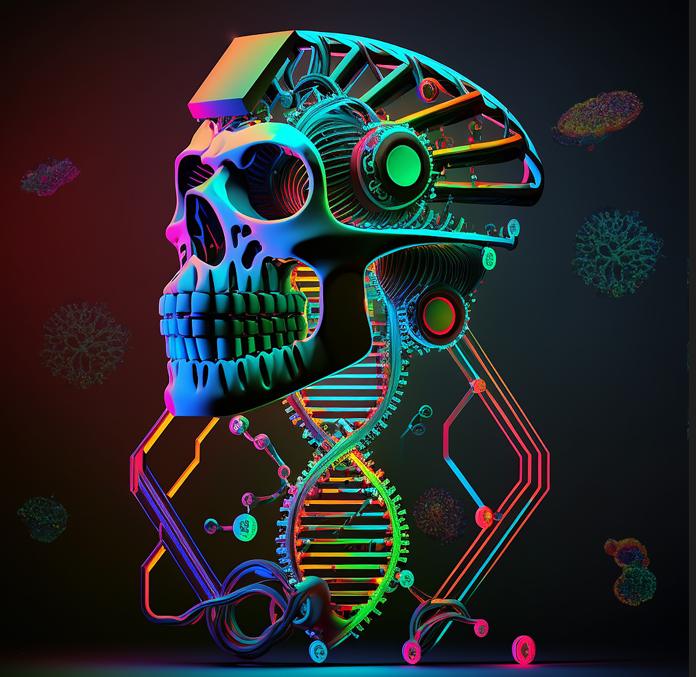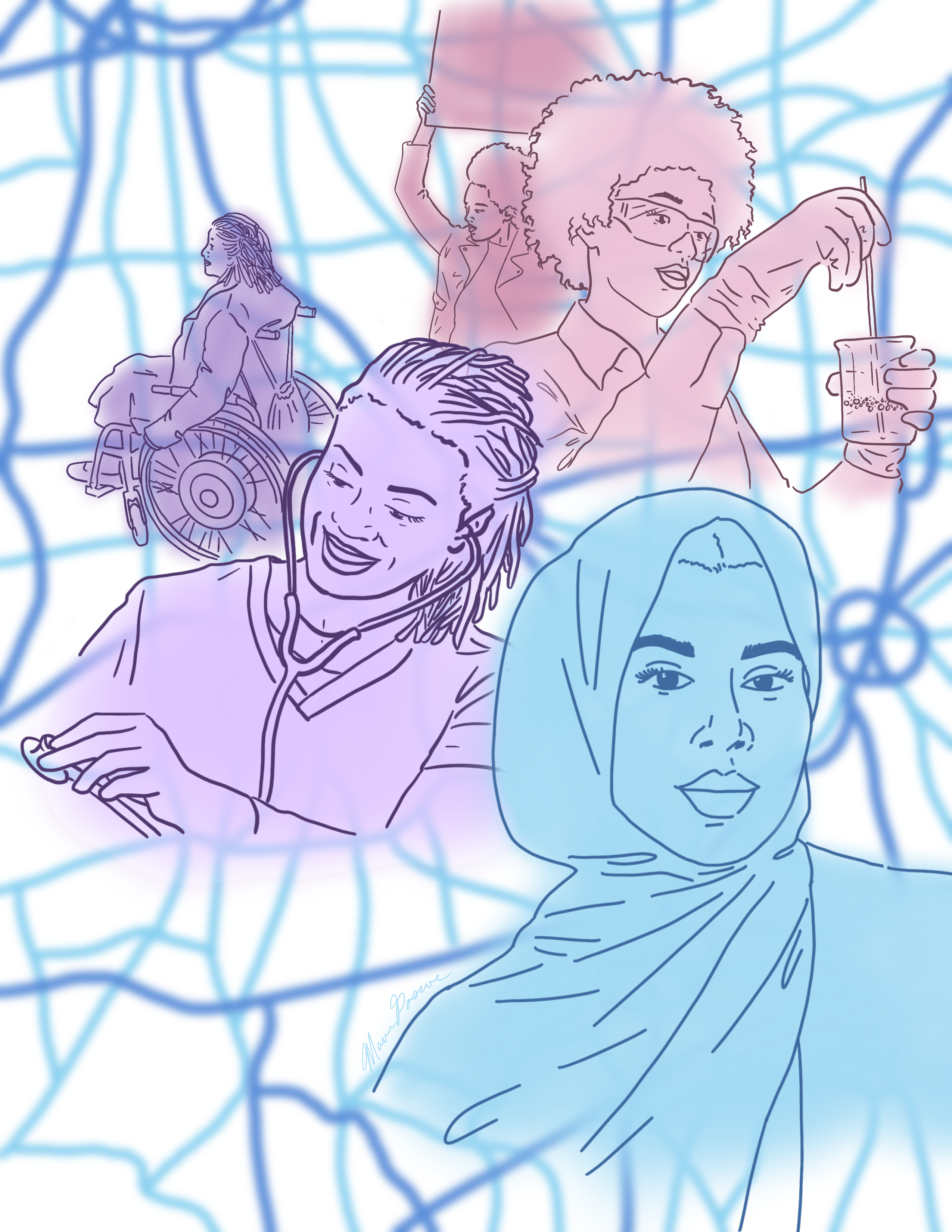2025 Graphic Design Winner
In 2025, the Program Committee decided to explore another direction for its annual conference showlook. ASBH is extremely grateful to all the artists that submitted their work, and we encourage you to consider a submission for the 2026 Annual Graphic Design Contest.
2024 Graphic Design Contest Winner
The 2024 Program Committee invited submissions of original art providing interpretations of the conference theme: What Does It Mean to Be Human? Eighteen submissions were received from both members and nonmembers. The winning design and the artist’s description appear below. The winning design was used as the graphic theme of the 2024 Annual Conference.
Winning Design

Artist: Sundeep Grandhe
"Unity in Diversity: The Essence of Humanity," artistically navigates the profound inquiry, "What Does It Mean to be Human?" through a captivating mosaic of diverse human faces, each portraying a unique emotion, collectively forming a human silhouette. This design encapsulates the multifaceted human experience, highlighting our shared emotions, ethical dilemmas, and the biological threads that connect us. The integration of DNA's double helix symbolizes the genetic foundation of life, underscoring our inherent diversity yet fundamental unity. By weaving in symbols of bioethics, the artwork prompts reflection on the ethical dimensions of our existence, emphasizing compassion, justice, and equality. This piece invites viewers to contemplate the essence of being human, celebrating our differences while acknowledging our interconnectedness, thus encapsulating the conference's theme through a visual exploration of humanity's complexity and the ethical considerations that define our collective human journey.
2023 Graphic Design Contest Winners
The 2023 Program Committee invited submissions of original art providing interpretations of the conference theme: Engaging the Past to Energize the Future: Creating Space for Inclusive Public Discourse. Fourteen submissions were received from both members and nonmembers. The winning design and the artist’s description appear below, along with art and descriptions for the 2023 honorable mentions. The winning design was used as the graphic theme of the 2023 Annual Conference.
Winning Design
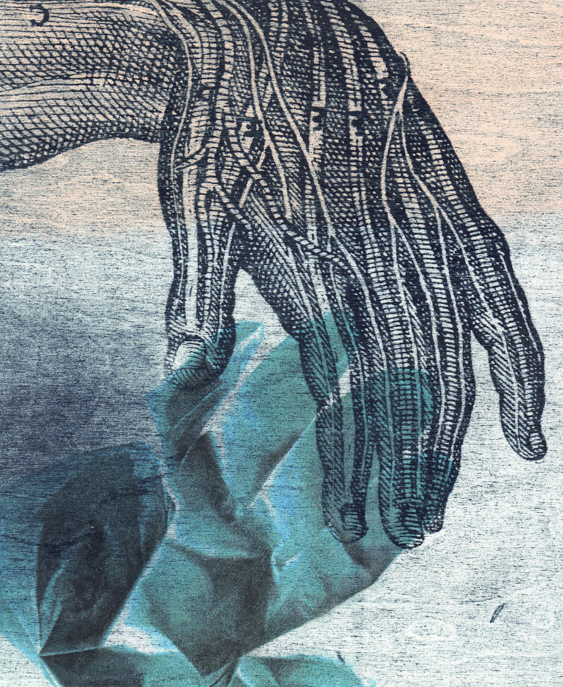
Artist: Darian Goldin Stahl
“Laboratory Study II” is one in a series of original prints that merge eras of scientific innovation and visual culture . Appropriating anatomical woodcuts and layering them with contemporary materials of medicine, such as this latex glove, the past and present reach towards one another . However, the discarded and crumpled feel of the glove, transparency of the hand, and the stylistic contrast between the two elements point to some essential conflict or disconnection . I aim for this work to provoke a dialogue on the state of healthcare today by considering how far it has come.
Honorable Mentions
Two designs were awarded honorable mention this year.
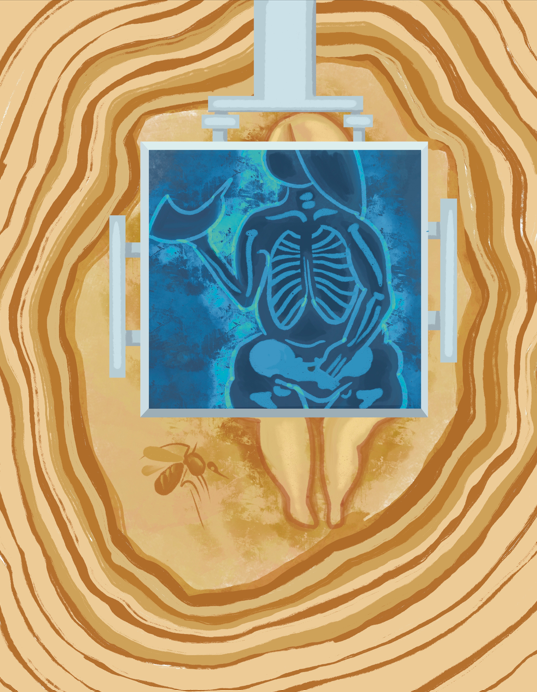
Artist: Julia O’Brien
This artwork depicts a stone carving of the Venus of Laussel from 23,000 BC, hypothetically receiving a modern X-ray. She’s holding a horn to amplify her voice over vast distances and timelines. I chose the subject of a Venus figurine because there are many theories of why we created them and what they represent, yet we do not know for sure. The imagery within this piece reforms time and language from barriers into opportunities . The mosquito in amber could be a prehistoric organic syringe from another perspective. The lines rippling out from the central figure resemble tree rings documenting the passage of time. The X-ray offers a modern medical view to the debate on who this figure was. Lastly, the X-ray creates an image by capturing the different rates at which rays travel through the body, representing how historical context gives us a bigger picture for discussion.
Artist: Ried Mackay
In the spirit of this year’s theme, I decided to use my passion for futurism and technology by developing an artistic piece using the artificial intelligence art generator Midjourney. I used photoshop to simply brighten colors and blend some images into the background and scale up the quality of the image. The biological structures and objects such as the viruses, cells, and DNA double helix represent the science that has been known to us now for many years—yet still holds mysteries that we are still discovering in a world that has been rocked by pandemic and ethical issues. These past discoveries and biological structures intertwine and combine with a skull made from synthetic gears and computer processor structures. This represents the increasing use of robotics, AI, and other advanced technologies in medicine and society that will increasingly lead to ethical issues and dilemmas we cannot even dream of yet.
2022 Graphic Design Contest Winner
In January 2022, the Program Committee was pleased to announce ASBH's third-annual Graphic Design contest. Members and nonmembers alike were invited to submit original art providing creative interpretations of the conference theme: Reimagining and Claiming the Role of Public Bioethics and Health Humanities. We asked artists to explore critically the many intersections of bioethics, health humanities, and the worlds with which we engage.
The committee received five submissions. The winner design and the creator's bio and artist statement appears below. This design was used as the graphic theme of the 2022 Annual Conference.
Winning Design
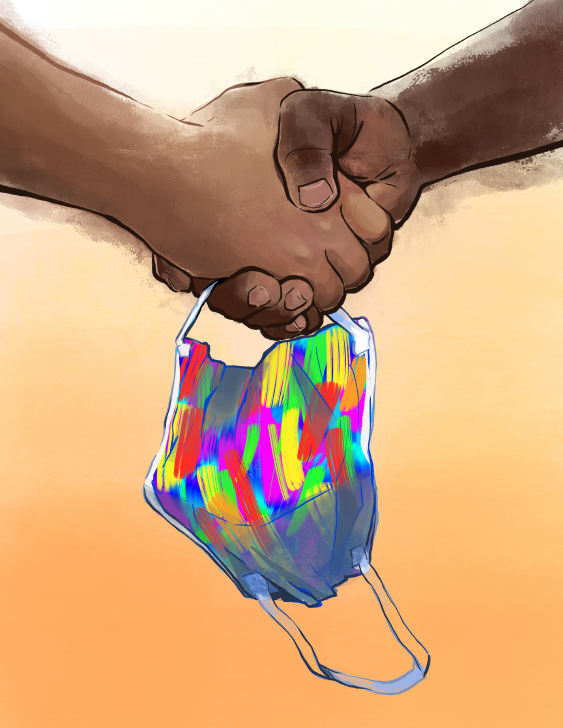
Artist: Laura Hansman
I am a third year medical student at Albany Medical College pursuing an MD. My research interests include bioethical issues surrounding those who experience incarceration.
Although we now rejoin one another in person after our isolation,Although we now rejoin one another in person after our isolation,we bring with us the grief, failings, and lessons of the COVID-19pandemic. This piece shows a handshake, representing reunion,while carrying the infamous mask, representing the pandemic.The bright colors of the mask symbolize the novel experiences andknowledge gained during this time and how we can use them topush the field of bioethics forward.
2021 Graphic Design Contest Winners
In our second-annual Graphic Design Contest, we received sixteen submissions from ASBH members and nonmembers, all engaging with the conference theme: Bioethics and Humanities at the Crossroads.
Sixteen submissions were received from in total. The winning design, the two designs receiving honorable mentions, and the creators’ bios and artist statements appear below.
First-Place Design
The winner submission, featured below, was used as the graphic theme of the 2021 Annual Conference. An adaptation of the original piece appears on the cover of the conference brochure and the web page.
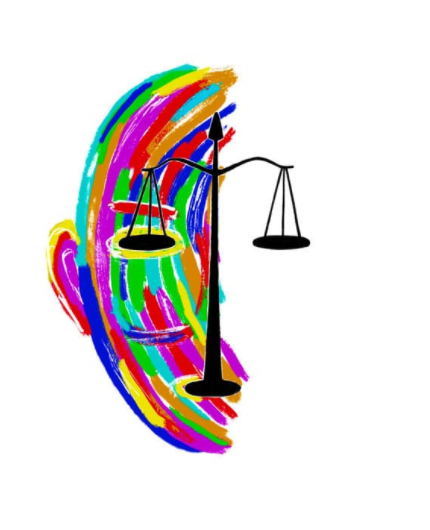
Artist: Jason Chen
I am the clinical ethics fellow at Ohio State University Wexner Medical Center. I have a PhD in philosophy with a specialization in the philosophy of well-being. I paint in my spare time.
This piece of art is composed of two objects: a human face and a scale. The former represents human culture and society, which is the object of study in the humanities. The latter represents the different values that need to be weighed against each other in the field of bioethics. Notice that the face is abstract and multicolored, symbolizing the interconnectedness of the issues we face as an international family. And notice the placement of the scale. It is not only an artistic expression of the theme of the conference but also of the weighing of values that takes place in our minds.
Honorable Mentions
Two designs were awarded honorable mention this year.
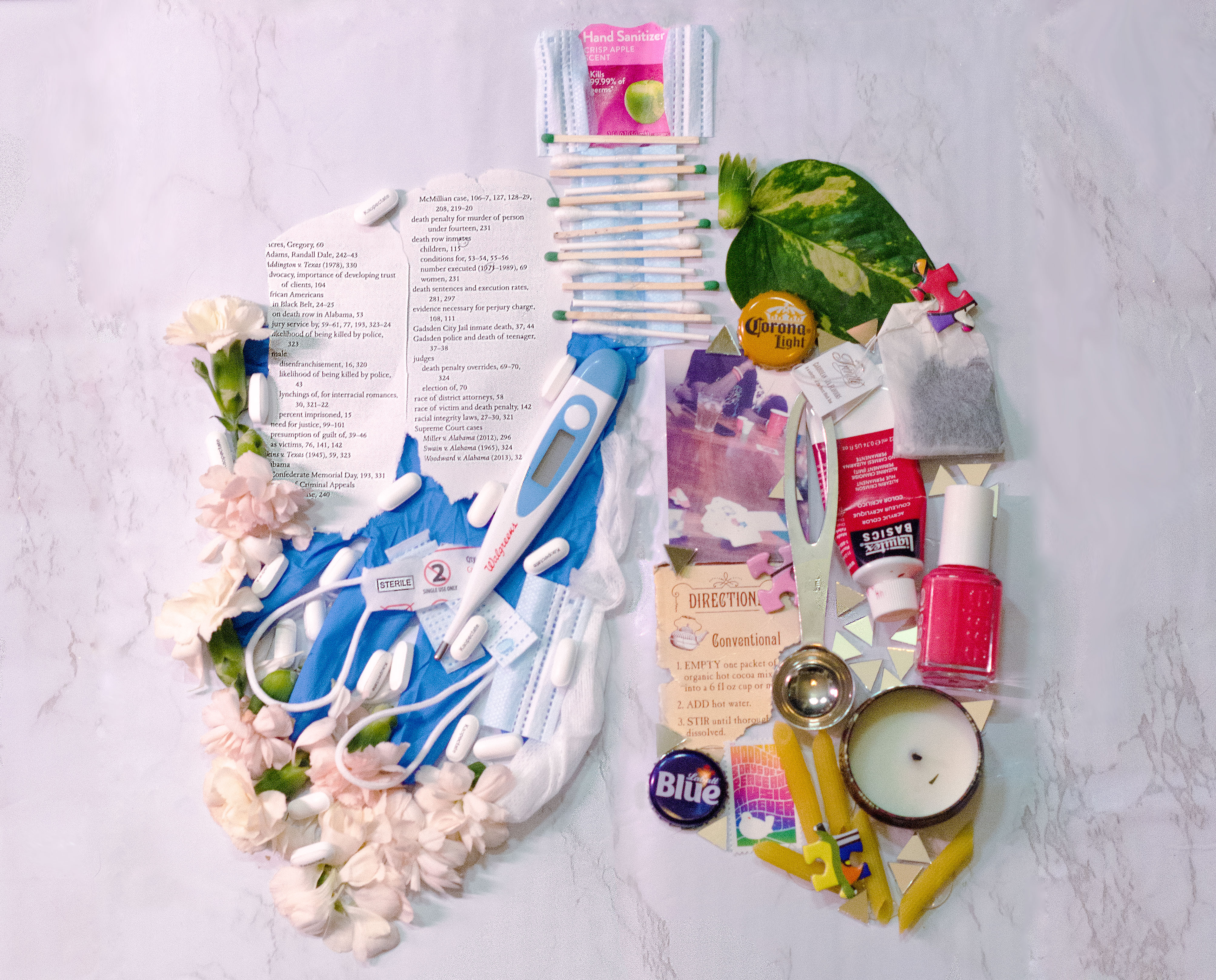
Artist: Maddie Berkvam
Maddie Berkvam is a first-year graduate student at Northwestern University, where she is pursuing a dual degree in Genetic Counseling and Medical Humanities + Bioethics. She received her BA from University of Wisconsin-Madison, where she studied Zoology and minored in Environmental Studies and Global Cultures. After graduating from UW-Madison in 2015, she spent 5 years in Chicago working as a medical copywriter before realizing her aspiration of becoming a genetic counselor. Upon completing her graduate education, she hopes to work as a pediatric oncology genetic counselor in an underserved area of Chicago, where she can help to improve access to testing services. Additionally, she would like to utilize her MHB degree to serve on a hospital ethics committee and continue to cultivate her love of writing. In her free time, she enjoys outdoor adventures with her dog Nile, pursuing new art projects, and binge-watching action movies.
The title of my piece is "Pandemic Privilege." Specifically, I aimed to visually portray the following: “The responses to COVID-19…have awakened deep concerns about our healthcare systems, systemic inequity, and divergent worldviews, as well as awareness of the potential for new alliances and creative solutions.” Pandemic Privilege represents starkly contrasting experiences of privilege and power in the wake of COVID-19, illustrated by the juxtaposing composition of the two lungs. The left lung is comprised of rubber gloves, pills, dilapidated peach carnations (symbolic of celebrations and milestones lost), a thermometer, disposable face masks, and a torn index page from the novel Just Mercy, which lists a number of pertinent terms, court cases, and historical references that underscore a disparagingly timeless theme of racial injustice and inequality. The right lung tells an entirely different story—one of privilege, hunkering down in comfort, guiltless indulgences, new hobbies, new memories, and new life.
Artist: Maeve Pascoe
Maeve Pascoe is a current medical student at the Cleveland Clinic Lerner College of Medicine of Case Western Reserve University pursuing a Doctorate of Medicine (MD) and a Master of Science in Clinical Research (MSc). She is a graduate of the University of Michigan and is involved with research at the Cleveland Clinic. Additionally, she enjoys expressing herself through art and recently received the Cleveland Clinic Center for Bioethics' first annual Anthony Thomas Jr. "Empathy and Valuing Every Person" Art Award.
Intersectionality is the future of bioethics and health because intersectionality reflects who we are. Our identities affect how we move through and work within the world, and no member of our communities holds only one identity. Our scientists, healthcare workers, and scholars/caregivers in the field of bioethics all hold unique identities that go beyond their professional roles that in turn provide unique perspectives to the field of bioethics and medical humanities. Our activism activates our compassion. Our own journeys with healthcare show us where we as a system can improve. By honoring and supporting each other for all that our experiences bring to our lives and our work, we can create stronger bonds with each other and come together to provide better care for our communities. Against a background of the literal crossroads of our nation, this piece represents a critical time in our history where we must amplify the voices around us. We can reach farther, move with greater intention, and impact more lives than ever if we take the time to incorporate the lived experiences of our colleagues into our approaches for care.

